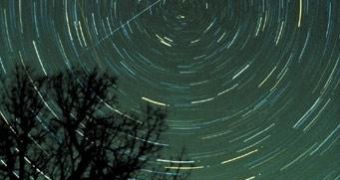From time to time, brief streaks of light may appear, moving rapidly across the night sky and disappearing just as quickly. We generally call these luminous phenomena 'shooting stars'; however, they have nothing in common with stars, except maybe a slight resemblance. In fact, shooting stars are meteoroids that burn into the atmosphere due to the heat generated through friction while traveling at high speeds. Generally, they range in sizes between a small pebble all the way to a boulder. Any larger and the object becomes an asteroid, while smaller meteorites are called planetary dust.
Most of these small cosmic bodies have the size of small pebbles and may be seen as they burn in the Earth's atmosphere from distances between 64 to 120 kilometers. Flashes of light created by some of the largest meteoroids are called fireballs or bolides, says Penn State University assistant professor of astronomy and astrophysics, Kevin Luhman.
"Meteors are falling all the time. There's debris all throughout the solar system. Every minute somewhere around the Earth there's some little piece of rock or ice that's falling from space," however we only see the ones falling down to Earth during nighttime.
The northern hemisphere is probably the best viewing spot for falling meteorites, in the early hours of the night when the Earth is facing the direction of its orbital trajectory around the Sun. "You're better off using just the naked eye versus the telescope, which shows just a small patch of sky. If you look at the entire sky, that gives you a better chance of spotting the meteor," says Luhman.
This space debris is left behind by asteroids and comets passing by Earth. Some of the best viewing times are when meteor showers exceed one to two meteors per minute; however, there are periodical meteor showers which may put off a light display of more than eleven meteors per minute. Periodical annual meteor showers are named accordingly with the constellation they appear to originate from, such as the Leonid meteor shower which originates in the Leo constellation, or the Perseids which seem to radiate from a point in the sky in the Perseus constellation.
The Perseid meteor shower, for example, is believed to be generated by a cloud of debris left behind by comet Swift-Tuttle some thousand years ago. Some meteor showers can become extremely violent, more than 100,000 meteors per hour appearing on the sky, such as the Leonid meteor shower that occurred in 1833, which scared people so much that they thought that the end of the world was coming.
"These rocks are basically leftovers or raw ingredients from when the solar system was born 4.5 billion years ago. If a comet or asteroid hits Mars, it can throw some of the pieces of the crust into space and, after millions of years, some of that material falls down to Earth's surface," said Luhman, while explaining the origin of these objects and their importance in the study of other planets.
Such a crust fragment, originating on Mars 3.6 billion years ago, came in the attention of the whole world in 1996, when it was shown to present some rock formation which appeared to bear evidence of primitive life. It was later showed that in fact the formation had just been a geologic effect, but although the scientific debate was put to an end, shooting stars will always be a part of our daily life.

 14 DAY TRIAL //
14 DAY TRIAL //